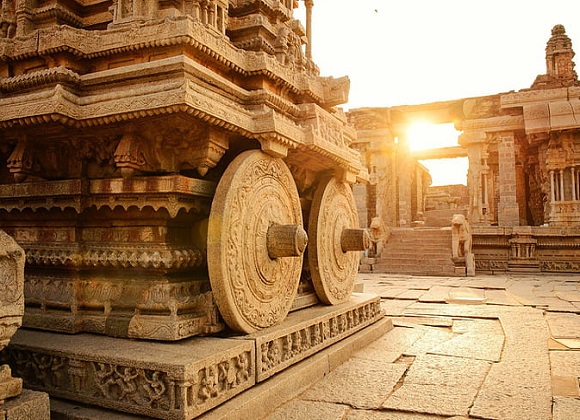Courses
Grow skills with quality courses

Stories of Indian Classrooms
Ms. Sneha Rahul Pardeshi is a teacher with an experience over a decade. Over the period of time Ms. Pardeshi has been actively engaged with Gurushala through different mediums. She strongly emphasizes on enhancement of teaching outcomes and uses out of the box methods of teaching. This interview documents her journey over the last 10 years with a strong message for both teacher and student communities. Tell us about yourself? My name is Sneha Rahul Pardeshi. I have been serving as a teacher for the last 11 years. The most crucial and the first thing which I learnt throughout this journey is the fact that there are no boundaries or limitations for how much an individual can teach. Teaching is an indispensable part of human evolution. It is an ocean without any depth and a profession which transcends time and place. Teachers have to constantly learn and keep updating themselves in order to meet the steps of change. They have to constantly endeavor to realize the vision of a great nation with bright future students. I am an ardent reader and writer. I love to create stories, plays and write-ups. I have created many works on fiction and imagination and have curated poetry around social issues like female infanticide. I have been actively engaged in the process of creating art through writing on a multitude of topics. I consider myself to be a lover and patron of creativity. Creating something different and spontaneous is one of my capabilities. My most favourite subject is Social Studies and Humanities which is considered to be a conventionally boring subject. But I strongly believe that it is altogether more important just like Science and Mathematics. One can trace the roots of socialization, the evolution of humanity and the behavioural theories through this subject. How human beings have evolved, how they can grow and become better, contribute more positively and become more responsible citizens are the questions which can be answered through this subject. What is your preferred way of teaching? Whenever I teach, I ensure that I don't take the textbook in my hand. I understand the chapter and the concept well through self study and then I try to deliver my lecture in a story-like format. I also include realistic elements in it to make it more relatable for children by ensuring that firstly I am taking examples from what is happening around us and secondly by involving students in the process of learning. It is important for them to relate to what they are learning. Mere rote learning and reading through textbooks isn't enough. Involving students makes the process of learning more interesting and interactive. This is of utmost importance in 21st century education. In the end, I put some analytical remarks as a conclusion and I also posed questions in front of students. This allows them to construct their own opinion and way of expression about a topic or an issue. Through their answers, I evaluate how well the lesson has been delivered to them. It also ensures the growth of problem solving and decision making skills in children. Like any other performing art, I consider my lectures to be an art and the children to be the audience. How well I have been able to convey the essence of my art is a test of my ability to deliver well. “I am not going to teach anything but you are going to learn everything”, is my opening line in most of my lectures before I proceed with interactive ways to engage my students. They shouldn't feel the burden of learning anything. Rather they should enjoy the process with effortless grace. What motivated you to become a teacher? Initially, after completing my 12th standard, I had a dream of becoming an IAS officer but somehow along the way, things unfolded in a way that I landed in the profession of teaching. But it was through that phase of transition that I realized my knack to teach. I realized that I have the ability to teach well and it comes naturally to me. With every step, I grew better as a teacher and soon I realized that if I wish to do anything for the society, it was the profession of teaching which could prove to be the perfect medium to fulfill that aspiration. After my marriage, I pursued degrees and attained more qualifications in the field of education and teaching. It is also my Guru and ideal Mrs. Megha Sandeep Pawar who have motivated and helped me to become what I am today. I hold utmost respect and reverence for her. She has truly been a great inspiration. She has taught me how to handle difficult and complex circumstances in the best possible way. She also happens to be the principal of the school where I teach which I believe is a beautiful coincidence and a wonderful blessing. Everyone needs a guru to grow and become in life. For me, that guru has been Mrs. Megha Pawar who has helped me become a better teacher and mold myself into a better individual. What is your best memory so far as a teacher? My best so far goes back to the time when I was appointed as a teacher for the very first time. I started teaching 5th standard as a substitute teacher and eventually moved onto becoming a full-time class teacher. I left the school and after almost 5 years when my batch was promoted to 10th standard, I got to know to hear from one of my colleagues from that school on the occasion of the 10th standard's farewell. To my surprise and utter delight, I got to know that despite being away for almost 5 years, my students still remembered me and showed gratitude in that event. They showed gratitude to my contribution in the beginning of their learning process when they almost started their school. Getting to know that I have been able to motivate so many children to become better learners and individuals is, I believe , to be my greatest success and the most beautiful memory. Those kids used to be last benchers who are now doing great things in life and constantly succeeding in the field of education and the professional sphere. This has been one of the most cherishing moments for me. That's a great thing for me. How were you introduced to Gurushala? First of all I would like to chant these mantras- गुरू ब्रह्मा गुरू विष्णु, गुरु देवो महेश्वरा गुरु साक्षात परब्रह्म, तस्मै श्री गुरुवे नमः|| I would also like to extend my warm wishes and heartfelt gratitude to Gurushala who have been a bright ray of hope for teachers and students, especially in times of covid when the future seemed bleak. When Pratham-Vodafone reached out to us with all the resources to build a better future for students and children, it was a moment of victory for all of us. Gurushala and its team for the last two years have been an indispensable part for the growth of schools, teachers and children. It has been the driving force for the betterment of society and teachers. When there was no one to help and support, Gurushala extended such strong support to all the teachers and children to realize the goal of growth and development. They helped us sail through tough times and Gurushala has become a Guru for us who have taught and motivated us a lot. What is your favourite section about Gurushala? One of my most favourite part about Gurushala has been the learnings which it offered on creation of worksheets. Another thing which I liked the most was a session by the team on digital literacy and use of ICT for teaching methodology. The one week workshop by Amit Sir on imparting quality education through online has also been wonderful. These sessions have helped us a lot in moving forward with the process of continuing our teaching even during times of pandemic. They also made us equipped with ICT tools which have become such an important part of the teaching field. The sessions on mental health, hygiene and gender equality have been brilliant. How has Gurushala helped you as a teacher? Gurushala has helped not only me but the society as well. The community ambassador program had been a beautiful program of Gurushala which helped us learn and grow together. The sharing of ideas, thoughts and solutions amongst teachers; the great lectures delivered by great personalities have proven to be immensely beneficial for all of us. We have learned and grew a lot through the process of getting something new from Gurushala. It has become better teachers and even better learners. Our constant growth has been fuelled by the efforts of Gurushala. In what activities of Gurushala have you participated? I have participated in many programs and activities of Gurushala. As mentioned, I have been a part of a community ambassador program. I was also a part of a small workshop on NCERT. I was also a participant of programs on teachers' day. I got associated with Gurushala in such a way that I became a participant of their programs which were organised every other month. There have been innumerable activities with Gurushala where I have taken part. I also received a letter of appreciation and a certificate of active participation from Gurushala. I was also made a panel member of teachers. All these events and opportunities have made me grateful towards Gurushala for their faith in me. It is through these recognitions that I have felt like an active agent of this society, someone whose efforts are worthy to be considered and someone who can contribute positively to the society. I am truly grateful for the opportunities that have been offered and the ones which I hope to get in future through Gurushala. What according to you is a 21st century teacher? A 21st century should be a complete and an ideal example of progress. He/ she should be the active agent of change, someone who can secure investments of today into positive returns of the future. A 21st century teacher should be able to contribute in the making of a nation, in the betterment of society and in helping youth to grow and become the future of tomorrow. He/she should be able to guide the demographic dividend of the country in the right direction. The teacher should be able to realize the visions of respected A.P.J. Abdul Kalam who envisioned a better and developed India in the future. What is your life motto as a teacher? My life motto as a teacher is to help my students to learn and use their learning in daily lives. My vision is to see them excel in life by inculcating whatever they learn through their classroom. To deliver more practical and rational content, to help students become better individuals and to motivate them to apply their learning in daily lives is my goal. They should be able to progress in both classroom and life. My dream is to bring 100 percent to India. Teaching is not just a profession. It is a noble cause and we as teachers have to ensure that the faith with which parents leave students with us for education should never get shaken. Rather it should be strengthened and everyone should be motivated to bring their children to school. How do you wish to bring change in society? Today's generation is rightly called the nano generation. The present generation is very advanced in the field of technology and social media. They have the required zeal and the force to utilize modern technology but it is our duty to channelize that force and zeal in the right direction. We have to educate them and influence them to contribute more positively to the growth of society. I as a teacher will try my best to do my bit in this regard.
Read MoreResearch & Policy
This globalized and digital world has significantly reduced the importance of exploring and educating ourselves about our rich art and architecture. Our Indian Constitution mentions some Fundamental Duties, which every Indian citizen is supposed to abide by. One of the fundamental duties is to value and preserve the rich heritage of our composite culture. The art, architecture, and culture of our country still have a great impact on our country’s economy, education, and society overall. It not only enriches one’s inner world but also illuminates one’s inner life and increases one’s creativity and imagination. This further enhances our tolerance and provides opportunities to unite with each other. This also helps in boosting well-being for communities and individuals alike. Temple architecture is an important aspect of art and architecture, which developed during ancient India and had distinct styles in different parts of the country as a result of its geographical, climatic, ethnic, racial, historical, and linguistic diversities. Talking about the Hindu Temple architecture, it reflected a synthesis of arts, beliefs, values, and the way of life cherished under Hinduism. The temple was considered a place for pilgrimage. Hindu temples were looked at as a place of a link between the man and his God. This helped him in his spiritual liberation that ultimately led to Moksha. Here, we would be discussing the Nagara or the Northern style and the Dravida or the Southern style of temple architecture. Let us begin by first understanding the differences and similarities between the two styles. The temples of North and South India were distinguished based on some specific features like sikhara and gateways. In the north Indian temples, the most prominent component was the sikhara while the gateway was generally unassuming. The most prominent features of South Indian temples were enclosures around the temples and the Gopurams (huge gateways), which led the devotees into the sacred courtyard. There were, however, many common features in the Northern and the Southern styles. These included the ground plan, positioning of stone-carved deities on the outside walls and the interior, and the range of decorative elements. Let us see some of the prominent features of the Nagara school of Architecture: It developed from the 5th century onwards in the northern part of India. The temple followed the Panchayatana style of temple making, which has the main shrine in between and is surrounded by subsidiary shrines. In front of the main shrine, they had the assembly halls. Outside the garbhagriha (womb chamber), sculptures of Ganga and Yamuna were placed. Water reservoirs were absent here. The vertical end of the shikhara ended in a horizontal fluted disc, known as the Amalak. On top of that Amalak, there was a spherical-shaped object known as the Kalash. The ambulatory passageway or the pradakshina path around the sanctum sanctorum was covered. Elaborate boundary walls or gateways were not present around the temple premises. The Kandariya Mahadeva Temple in Khajuraho in Madhya Pradesh is a fine example of this style. The Dravida School of Architecture developed in the Southern part of India and spread to many countries. Some of its important features are: Unlike the Nagara temples, the Dravidian temples were surrounded by high boundary walls. The front wall had a high entrance gateway known as gopuram. The temple premise was laid out in panchayatan style. Under the Dravidian style, the spire is in the form of a stepped pyramid. It is known as vimana. The assembly hall was connected with the garbhagriha by a vestibular tunnel known as antarala. The entrance of the garbhagriha had sculptures of Dwaarpal, mithun, and yaksha. The presence of a water tank inside the temple enclosure was a unique feature of the Dravidian style. Brihadeeswara Temple at Thanjavur is an example of the same. It was built by Tamil king Raja Raja Chola I between 1003 and 1010 AD. It is part of the UNESCO World Heritage Site and is referred to as the “Great Living Chola Temples”. The importance of temples in our daily lives, inspired many intellectual and religious movements engaging the different cohorts like the architects, artisans, and artists from different parts of the society to be actively engaged in the evolution of temple architecture.
Read More
The Arts
ज़िन्दगी की हर राह में , धूप में , छाँव में , सुख में , दुःख में , या ,जब कभी मैं चुप होता हूँ , अब मैं कहता नहीं कुछ , बस, लिख लेता हूँ ! हास में , विनोद में, प्रेम में, प्रमोद में, विशेष में , अमोघ में , या, जब कभी मैं खुश होता हूँ , अब मैं कहता नहीं कुछ , बस, लिख लेता हूँ ! रीत में , प्रीत में, रीस में , टीस में, प्रत्यक्ष में, परोक्ष में, या ,जब कभी मैं लुप्त होता हूँ, अब मैं कहता नहीं कुछ , बस, लिख लेता हूँ ! गर्व में , अभिमान में , सफलता के आसमान में , बात के सम्मान में , या, जब कभी , में कुछ खोता हूँ , अब मैं कहता नहीं कुछ , बस, लिख लेता हूँ !
Read More
A photo journey & picture-led storytelling of informative topics for you and your students! Download today to share. Every picture tells a story, so let's dive into them and make it a learning process.
Let's freshen our minds and spend time with ourselves. A space for you and your entertainment! Participate in quizzes, challenges, and listen to our podcast to test your knowledge on a variety of fun and interesting topics and learn about yourself!
